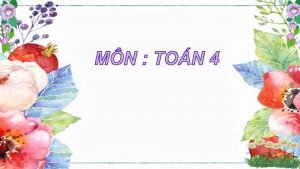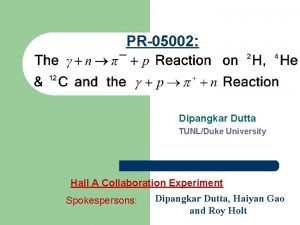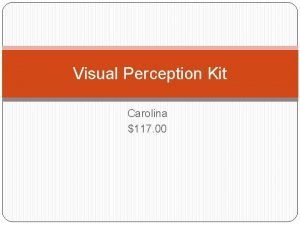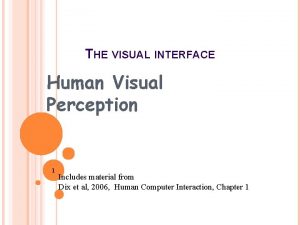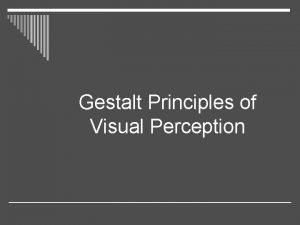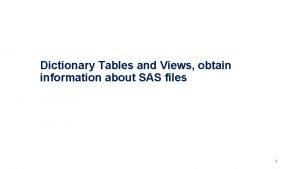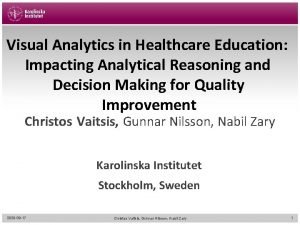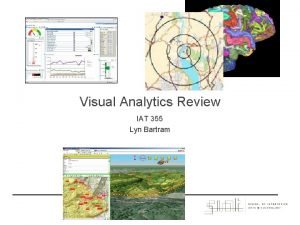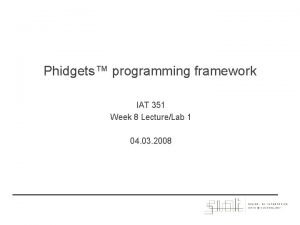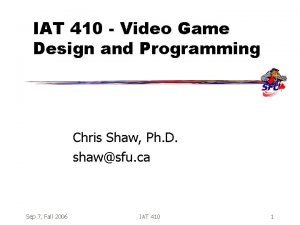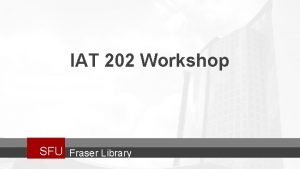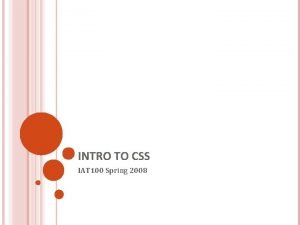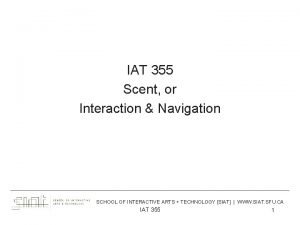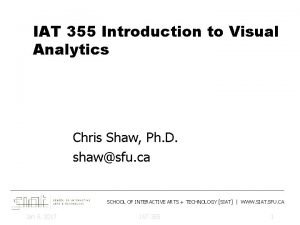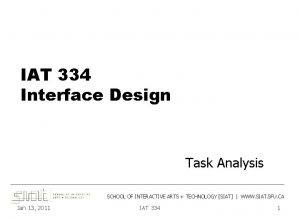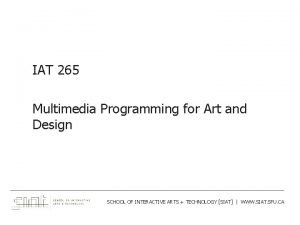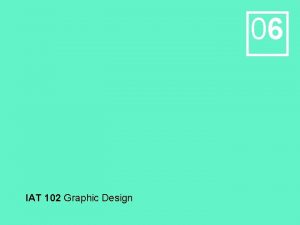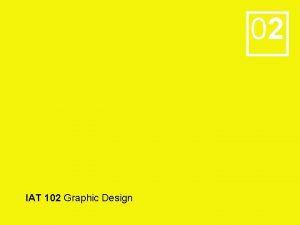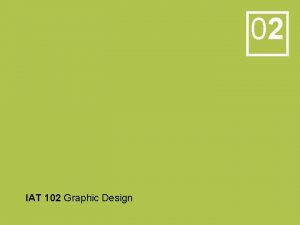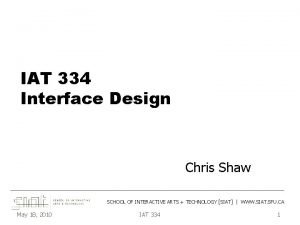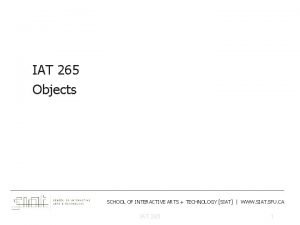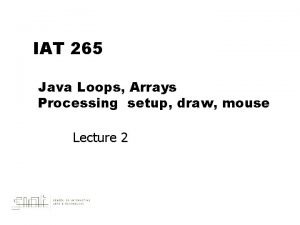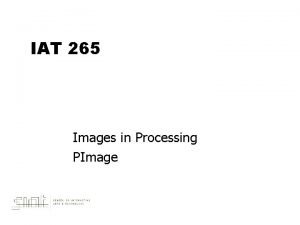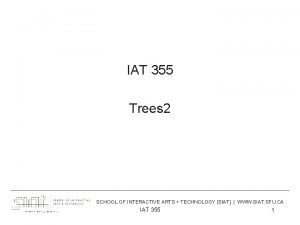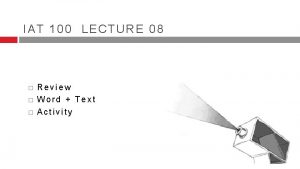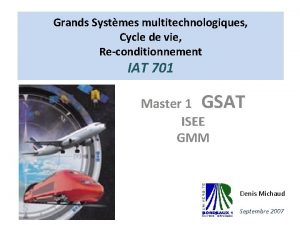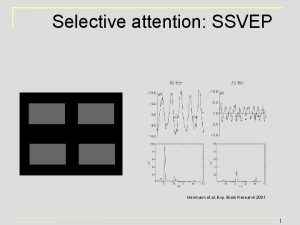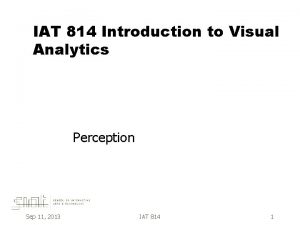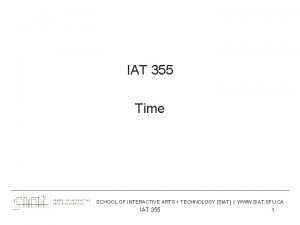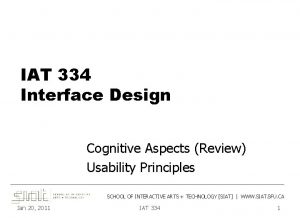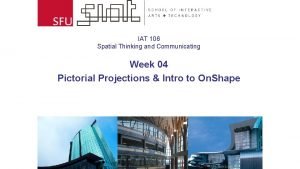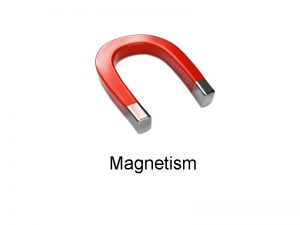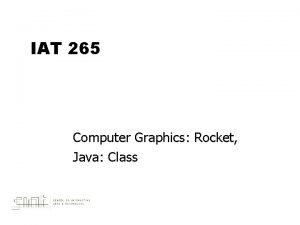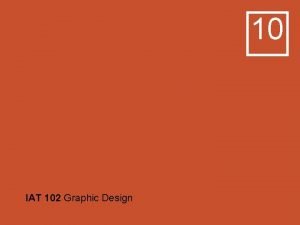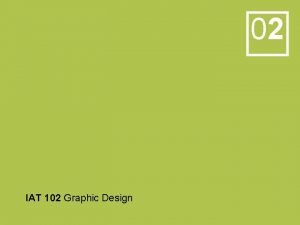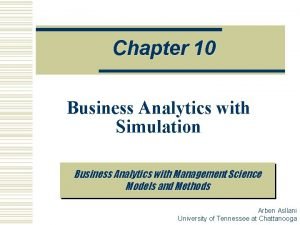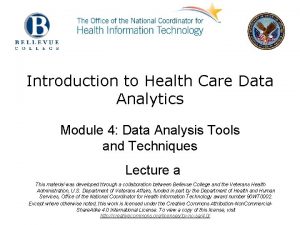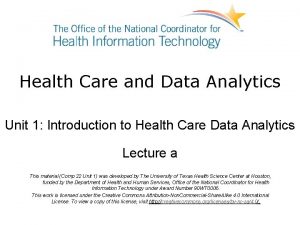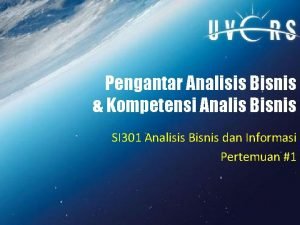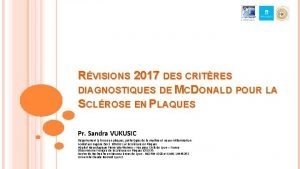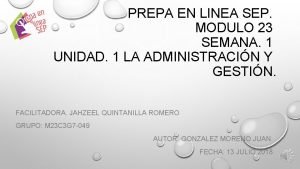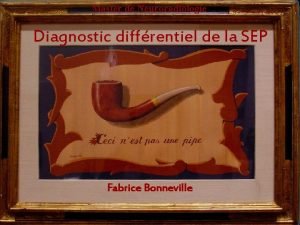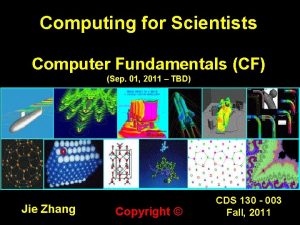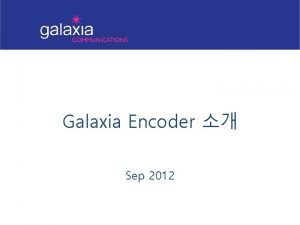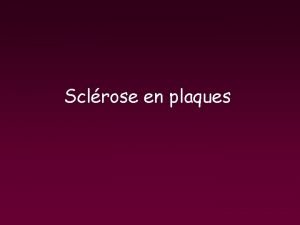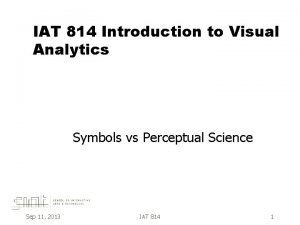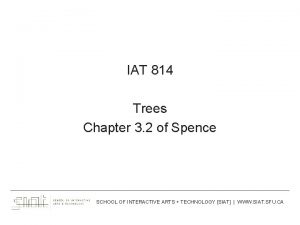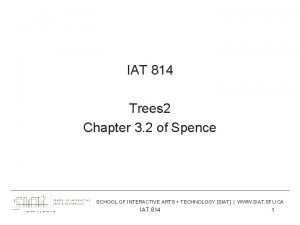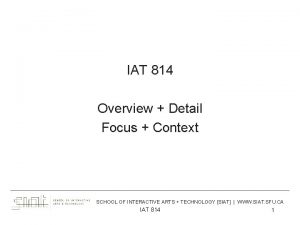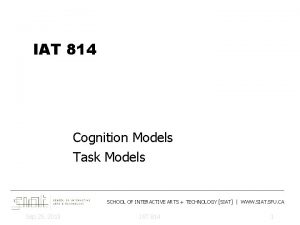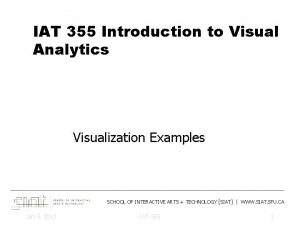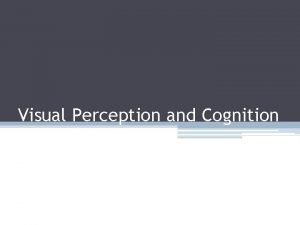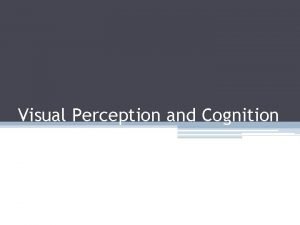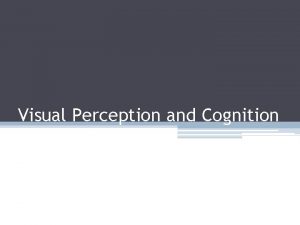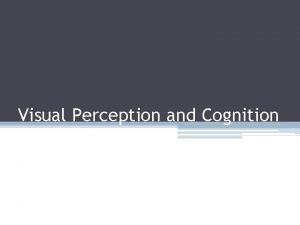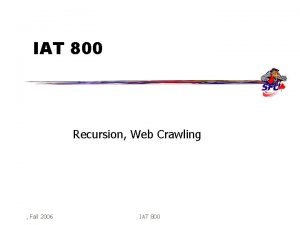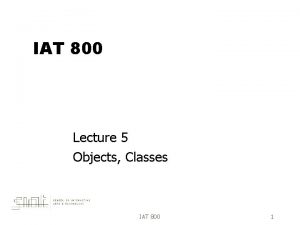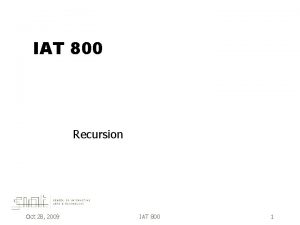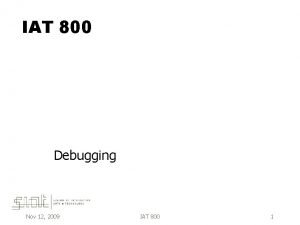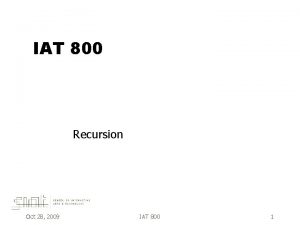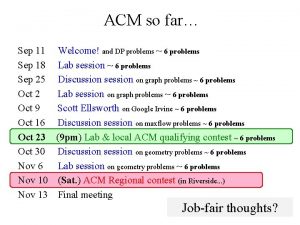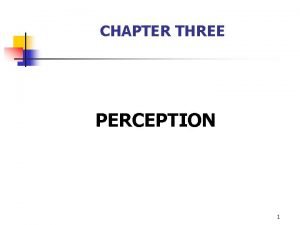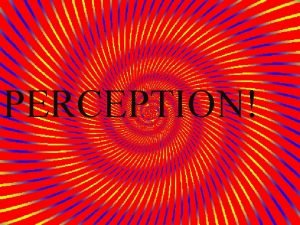IAT 814 Introduction to Visual Analytics Perception Sep














































![Stevens’ Power Law [Stevens 1961] Sep 11, 2013 IAT 814 47 Stevens’ Power Law [Stevens 1961] Sep 11, 2013 IAT 814 47](https://slidetodoc.com/presentation_image/b0de1aebc9a365ca5b03ed7edf4ccf49/image-47.jpg)














![Integral vs. Separable Dimensions Integral [Ware 2000] Sep 11, 2013 IAT 814 Separable 62 Integral vs. Separable Dimensions Integral [Ware 2000] Sep 11, 2013 IAT 814 Separable 62](https://slidetodoc.com/presentation_image/b0de1aebc9a365ca5b03ed7edf4ccf49/image-62.jpg)


- Slides: 64

IAT 814 Introduction to Visual Analytics Perception Sep 11, 2013 IAT 814 1

Perceptual Processing g Seek to better understand visual perception and visual information processing – Multiple theories or models exist – Need to understand physiology and cognitive psychology Sep 11, 2013 IAT 814 2

A Simple Model g Two stage process – Parallel extraction of low-level properties of scene – Sequential goal-directed processing Stage 1 Eye Sep 11, 2013 Early, parallel detection of color, texture, shape, spatial attributes IAT 814 Stage 2 Serial processing of object identification (using memory) and spatial layout, action 3

Stage 1 - Low-level, Parallel g Neurons in eye & brain responsible for different kinds of information – – – – Orientation, color, texture, movement, etc. Arrays of neurons work in parallel Occurs “automatically” Rapid Information is transitory, briefly held in iconic store Bottom-up data-driven model of processing Often called “pre-attentive” processing Sep 11, 2013 IAT 814 4

Stage 2 - Sequential, Goal. Directed Splits into subsystems for object recognition and for interacting with environment g Increasing evidence supports independence of systems for symbolic object manipulation and for locomotion & action g First subsystem then interfaces to verbal linguistic portion of brain, second interfaces to motor systems that control muscle movements g Sep 11, 2013 IAT 814 5

Stage 2 Attributes g Slow serial processing g Involves working and long-term memory g Top-down processing Sep 11, 2013 IAT 814 6

Preattentive Processing g How does human visual system analyze images? – Some things seem to be done preattentively, without the need for focused attention – Generally less than 200 -250 msecs (eye movements take 200 msecs) – Seems to be done in parallel by low-level vision system Sep 11, 2013 IAT 814 7

How Many 3’s? 1281768756138976546984506985604982826762 98098584582245098564589450980943585 9091030209905959595772564675050678904567 8845789809821677654876364908560912949686 Sep 11, 2013 IAT 814 8

How Many 3’s? 1281768756138976546984506985604982826762 98098584582245098564589450980943585 9091030209905959595772564675050678904567 8845789809821677654876364908560912949686 Sep 11, 2013 IAT 814 9

What Kinds of Tasks? g Target detection – Is something there? g Boundary detection – Can the elements be grouped? g Counting – How many elements of a certain type are present? Sep 11, 2013 IAT 814 10

Examples: g Where is the red circle? Left or right? g Put your hand up as soon as you see it. Sep 11, 2013 IAT 814 11

Pre-attentive Hue g Can Sep 11, 2013 be done rapidly IAT 814 12

Examples: g Where is the red circle? Left or right? g Put your hand up as soon as you see it. Sep 11, 2013 IAT 814 13

Shape Sep 11, 2013 IAT 814 14

Examples: g Where is the red circle? Left or right? g Put your hand up as soon as you see it. Sep 11, 2013 IAT 814 15

Hue and Shape Cannot be done preattentively g Must perform a sequential search g Conjuction of features (shape and hue) causes it g Sep 11, 2013 IAT 814 16

Examples g Is there a boundary: – A connected chain of features that cross the rectangle g Put Sep 11, 2013 your hand up as soon as you see it. IAT 814 17

Fill and Shape Left can be done preattentively since each group contains one unique feature g Right cannot (there is a boundary!) since the two features are mixed (fill and shape) g Sep 11, 2013 IAT 814 18

Examples g Is there a boundary? Sep 11, 2013 IAT 814 19

Hue versus Shape g g Left: Boundary detected preattentively based on hue regardless of shape Right: Cannot do mixed color shapes preattentively Sep 11, 2013 IAT 814 20

Hue vs. Brightness Left: Varying brightness seems to interfere g Right: Boundary based on brightness can be done preattentively g Sep 11, 2013 IAT 814 21

Preattentive Features g Certain visual forms lend themselves to preattentive processing g Variety of forms seem to work g In the next slide, spot the region of different shapes, both left and right Sep 11, 2013 IAT 814 22

3 -D Figures g 3 -D Sep 11, 2013 visual reality has an influence IAT 814 23

Emergent Features Sep 11, 2013 IAT 814 24

Potential PA Features length g width g size g curvature g number g terminators g intersection g closure g Sep 11, 2013 hue g intensity g flicker g direction of motion g stereoscopic depth g 3 -D depth cues g lighting direction g IAT 814 25

Key Perceptual Properties g Brightness g Color g Texture g Shape Sep 11, 2013 IAT 814 26

Luminance/Brightness g Luminance – Measured amount of light coming from some place g Brightness – Perceived amount of light coming from source Sep 11, 2013 IAT 814 27

Brightness g Perceived brightness is non-linear function of amount of light emitted by source Typically a power function S = a. In S - sensation I - intensity g Very Sep 11, 2013 different on screen versus paper IAT 814 28

Greyscale g Probably not best way to encode data because of contrast issues – Surface orientation and surroundings matter a great deal – Luminance channel of visual system is so fundamental to so much of perception • We can get by without color discrimination, but not luminance Sep 11, 2013 IAT 814 29

Greyscale g White Sep 11, 2013 and Black are not fixed IAT 814 30

Greyscale g White Sep 11, 2013 and Black are not fixed! IAT 814 31

Color Systems g HSV: Hue, Saturation, Value – Hue: Color type – Saturation: “Purity” of color – Value: Brightness Sep 11, 2013 IAT 814 32

CIE Space g The Sep 11, 2013 perceivable set of colors IAT 814 33

CIE L*a*b* g http: //www. gamutvision. com/docs/printest. html Sep 11, 2013 IAT 814 34

Color Categories g Are there certain canonical colors? – Post & Greene ’ 86 had people name different colors on a monitor – Pictured are ones with > 75% commonality Sep 11, 2013 IAT 814 35

Luminance g Foreground must be distinct from background! Can Can Can Sep 11, 2013 you you you read read this this text? text? IAT 814 36

Color for Categories g Can different colors be used for categorical variables? – Yes (with care) – Colin Ware’s suggestion: 12 colors • red, green, yellow, blue, black, white, pink, cyan, gray, orange, brown, purple Sep 11, 2013 IAT 814 37

Why 12 colors? Sep 11, 2013 IAT 814 38

Just-Noticeable Difference g Which Sep 11, 2013 is brighter? IAT 814 39

Just-Noticeable Difference g Which is brighter? (130, 130) Sep 11, 2013 (140, 140) IAT 814 40

Weber’s Law In the 1830’s, Weber made measurements of the just-noticeable differences (JNDs) in the perception of weight and other sensations. g He found that for a range of stimuli, the ratio of the JND ΔS to the initial stimulus S was relatively constant: g ΔS / S = k Sep 11, 2013 IAT 814 41

Weber’s Law g Ratios more important than magnitude in stimulus detection g For example: we detect the presence of a change from 100 cm to 101 cm with the same probability as we detect the presence of a change from 1 to 1. 01 cm, even though the discrepancy is 1 cm in the first case and only. 01 cm in the second. Sep 11, 2013 IAT 814 42

Weber’s Law g Most continuous variations in magnitude are perceived as discrete steps g Examples: Sep 11, 2013 contour maps, font sizes IAT 814 43

Weber’s Law g Most continuous variations in magnitude are perceived as discrete steps g Examples: Sep 11, 2013 contour maps, font sizes IAT 814 44

Stevens’ Power Law g Compare Sep 11, 2013 area of circles: IAT 814 45

Stevens’ Power Law s(x) = axb s is the sensation x is the intensity of the attribute a is a multiplicative constant b is the power b > 1: overestimate b < 1: underestimate Sep 11, 2013 [graph from Wilkinson 99] IAT 814 46
![Stevens Power Law Stevens 1961 Sep 11 2013 IAT 814 47 Stevens’ Power Law [Stevens 1961] Sep 11, 2013 IAT 814 47](https://slidetodoc.com/presentation_image/b0de1aebc9a365ca5b03ed7edf4ccf49/image-47.jpg)
Stevens’ Power Law [Stevens 1961] Sep 11, 2013 IAT 814 47

Stevens’ Power Law Experimental results for b: Length Area Volume . 9 to 1. 1. 6 to. 9. 5 to. 8 Heuristic: b ~ 1/sqrt(dimensionality) Sep 11, 2013 IAT 814 48

Stevens’ Power Law g Apparent magnitude scaling [Cartography: Thematic Map Design, p. 170, Dent, 96] S = 0. 98 A 0. 87 [J. J. Flannery, The relative effectiveness of some graduated point symbols in the presentation of quantitative data, Canadian Geographer, 8(2), pp. 96 -109, 1971] [slide from Pat Hanrahan] Sep 11, 2013 IAT 814 49

Relative Magnitude Estimation Most accurate Position (common) scale Position (non-aligned) scale Length Slope Angle Least accurate Sep 11, 2013 Area Volume Color (hue/saturation/value) IAT 814 50

Color Sequence g Can Sep 11, 2013 you order these? IAT 814 51

Possible Color Sequences Grey Scale Sep 11, 2013 Full Spectral Scale Partial Spectral Scale IAT 814 Single Hue Scale Double-ended Hue Scale 52

Heat. Map Sep 11, 2013 IAT 814 53

Color. Brewer Sep 11, 2013 IAT 814 54

Color Purposes g Call attention to specific data g Increase appeal, memorability g Increase number of dimensions for encoding data – Example, Ware and Beatty ‘ 88 • x, y - variables 1 & 2 • amount of r, g, b - variables 3, 4, & 5 Sep 11, 2013 IAT 814 55

Using Color g Modesty! Less is more g Use blue in large regions, not thin lines g Use red and green in the center of the field of view (edges of retina not sensitive to these) g Use black, white, yellow in periphery g Use adjacent colors that vary in hue & value Sep 11, 2013 IAT 814 56

Using Color g For large regions, don’t use highly saturated colors (pastels a good choice) g Do not use adjacent colors that vary in amount of blue g Don’t use high saturation, spectrally extreme colors together (causes after images) g Use color for grouping and search Sep 11, 2013 IAT 814 57

Texture g Appears to be combination of – orientation – scale – contrast g Complex Sep 11, 2013 attribute to analyze IAT 814 58

Shape, Symbol g Can you develop a set of unique symbols that can be placed on a display and be rapidly perceived and differentiated? g Application for maps, military, etc. g Want to look at different preattentive aspects Sep 11, 2013 IAT 814 59

Glyph Construction g Suppose that we use two different visual properties to encode two different variables in a discrete data set – color, size, shape, lightness g Will the two different properties interact so that they are more/less difficult to untangle? – Integral - two properties are viewed holistically – Separable - Judge each dimension independently Sep 11, 2013 IAT 814 60

Integral-Separable g Not Sep 11, 2013 one or other, but along an axis IAT 814 61
![Integral vs Separable Dimensions Integral Ware 2000 Sep 11 2013 IAT 814 Separable 62 Integral vs. Separable Dimensions Integral [Ware 2000] Sep 11, 2013 IAT 814 Separable 62](https://slidetodoc.com/presentation_image/b0de1aebc9a365ca5b03ed7edf4ccf49/image-62.jpg)
Integral vs. Separable Dimensions Integral [Ware 2000] Sep 11, 2013 IAT 814 Separable 62

Shapes g Superquadric surface can be used to display 2 dimensions g Color could be added Sep 11, 2013 IAT 814 63

Change Blindness g Is the viewer able to perceive changes between two scenes? – If so, may be distracting – Can do things to minimize noticing changes – http: //www. psych. ubc. ca/~rensink/flicker/download/ – http: //nivea. psycho. univ-paris 5. fr/ECS/kayakflick. gif Sep 11, 2013 IAT 814 64
 The endowment assurance policy (plan-14)
The endowment assurance policy (plan-14) 186954 + 247436
186954 + 247436 57696+814
57696+814 Endowment plan 814
Endowment plan 814 Teramond
Teramond Gestalt principle of visual perception
Gestalt principle of visual perception Carolina visual perception kit
Carolina visual perception kit Visual perception in hci
Visual perception in hci Gestalt
Gestalt Sas dictionary tables
Sas dictionary tables Uhv valve
Uhv valve Visual analytics in healthcare
Visual analytics in healthcare Iat 355
Iat 355 Iat
Iat Gmayag
Gmayag Sfu surrey library
Sfu surrey library Iat 100
Iat 100 Iat 355
Iat 355 Iat 355
Iat 355 Iat 334
Iat 334 Multimedia programming languages
Multimedia programming languages Sfu iat 102
Sfu iat 102 Iat 102
Iat 102 Iat 102
Iat 102 Iat 334
Iat 334 Iat 265
Iat 265 Iat 265
Iat 265 Pimage processing
Pimage processing Iat 106
Iat 106 Zoomology
Zoomology Iat 100
Iat 100 Iat-maglev
Iat-maglev Coombs reagent
Coombs reagent Iat
Iat Iat
Iat Iat 355
Iat 355 Iat 334
Iat 334 Iat 106
Iat 106 Iat-maglev
Iat-maglev Iat 265
Iat 265 Iat 106
Iat 106 Graphic design
Graphic design Emil ruder
Emil ruder Certification in hotel industry analytics
Certification in hotel industry analytics Introduction to business analytics using simulation
Introduction to business analytics using simulation Introduction to healthcare data analytics
Introduction to healthcare data analytics Unit 1 health care systems
Unit 1 health care systems Introduction to business analytics
Introduction to business analytics Pharmacy exchange program
Pharmacy exchange program Sep gliwice
Sep gliwice Critères mcdonald sclérose en plaque
Critères mcdonald sclérose en plaque Modulo 23 semana 2 fase 4
Modulo 23 semana 2 fase 4 Master sep
Master sep Nueva escuela mexicana
Nueva escuela mexicana Incose asep certification
Incose asep certification Sep computer
Sep computer Sep i
Sep i Complejo sep dique la viña
Complejo sep dique la viña Complejo sep dique la viña
Complejo sep dique la viña Ece sep
Ece sep Scorstim
Scorstim Cnn 10 sept 7
Cnn 10 sept 7 Escuela segura sep
Escuela segura sep Escuela segura sep
Escuela segura sep Conesthgo
Conesthgo

